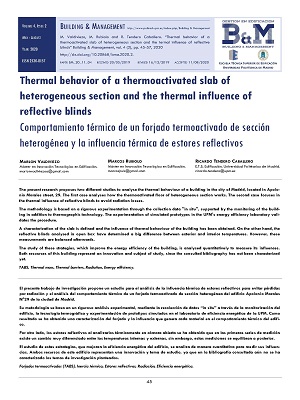
Thermal behavior of a thermoactivated slab of heterogeneous section and the thermal influence of reflective blinds = Comportamiento térmico de un forjado termoactivado de sección heterogénea y la influencia térmica de estores reflectivos
DOI: https://doi.org/10.20868/bma.2020.2.4695
Texto completo:
PDFResumen
Abstract
The present research proposes two different studies to analyse the thermal behaviour of a building in the city of Madrid, located in Apolo-nio Morales street, 29. The first case analyses how the thermoactivated floor of heterogeneous section works. The second case focuses in the thermal influence of reflective blinds to avoid radiation losses.
The methodology is based on a rigorous experimentation through the collection data "in situ", supported by the monitoring of the build-ing in addition to thermographic technology. The experimentation of simulated prototypes in the UPM's energy efficiency laboratory vali-dates the procedure.
A characterization of the slab is defined and the influence of thermal behaviour of the building has been obtained. On the other hand, the reflective blinds analysed in open box have determined a big difference between exterior and interior temperatures. However, these measurements are balanced afterwards.
The study of these strategies, which improve the energy efficiency of the building, is analysed quantitatively to measure its influences. Both resources of this building represent an innovation and subject of study, since the consulted bibliography has not been characterized yet.
Resumen
El presente trabajo de investigación propone un estudio para el análisis de la influencia térmica de estores reflectivos para evitar pérdidas por radiación y el análisis del comportamiento térmico de un forjado termoactivado de sección heterogénea del edificio Apolonio Morales N°29 de la ciudad de Madrid.
Su metodología se basa en un riguroso análisis experimental, mediante la recolección de datos “in situ” a través de la monitorización del edificio, la tecnología termográfica y experimentación de prototipos simulados en el laboratorio de eficiencia energética de la UPM. Como resultado se ha obtenido una caracterización del forjado y la influencia que genera cada material en el comportamiento térmico del edifi-co.
Por otro lado, los estores reflectivos al analizarlos térmicamente en cámara abierta se ha obtenido que en las primeras series de medición existe un cambio muy diferenciado entre las temperaturas internas y externas, sin embargo, estas mediciones se equilibran a posterior.
El estudio de estas estrategias, que mejoran la eficiencia energética del edificio, se analiza de manera cuantitativa para medir sus influen-cias. Ambos recursos de este edificio representan una innovación y tema de estudio, ya que en la bibliografía consultada aún no se ha caracterizado los temas de investigación planteados.
Palabras clave
Referencias
G. JIFAN. The Next Energy Revolution is Here. , 2017 Available from:https://www.weforum.org/agenda/2017/09/next-energy-revolution-already-here/.
Cálculo de parámetros característicos de la envolve nte. Da Db-He / 1.
China just Switched on the World's Largest Floating Solar Power Plant. [viewed Apr 11, 2018]. Available from:https://www.weforum.org/agenda/2017/06/china-worlds-largest-floating-solar-power/.
RODRIGUEZ-UBINAS, E., et al. Passive Design Strategies and Performance of Net Energy Plus Houses. , 2014 Available from: http://www.sciencedirect.com/science/article/pii/S0378778814003430 ISBN 0378-7788. DOI //doi.org/10.1016/j.enbuild.2014.03.074.
PUERTOLAS, R. Influencia De Las Estrategias Pasivas De La Envolvente En El Confort Térmico De Un Edificio Bioclimático. Universidad Politécnica de Madrid, 2017.
D. Sánchez C. Sánchez-Guevara and C. Rubio. El Enfoque Adaptativo Del Confort Térmico En Sevilla = the Adaptive Approach to Thermal Comfort in Seville. Anales De Edificación, Apr 1, 2016, vol. 2, no. 1. pp. 38-48. Available from: https://doaj.org/article/ca71d3c99d08496fbe2c3e711e647c6a ISSN 2444-1309. DOI 10.20868/ade.2016.3197.
VILLANUEVA, A. Guía Sobre Estructuras Termoactivas Y Sistemas Inerciales En La Climatización De Edificios . , Madrid, 2014.
PEREDA, L. Integración De Sistemas Termoactivos Para Eficiencia. Principios Y Caos. Guía Sobre Estructuras Termoactivas Y Sistemas Inerciales En La Climatiza-ción Del Edificio., Madrid, 2014. pp. 162.
ROMANÍ, J., DE GRACIA, A. and CABEZA, L.F. Simulation and Control of Thermally Activated Building Systems (TABS). , 2016 Available from: http://www.sciencedirect.com/science/article/pii/S0378778816304261 ISBN 0378-7788. DOI //doi.org/10.1016/j.enbuild.2016.05.057.
PARK, S.H., CHUNG, W.J., YEO, M.S. and KIM, K.W. Evaluation of the Thermal Performance of a Thermally Activated Building System (TABS) According to the Thermal Load in a Residential Building. , 2014 Available from: http://www.sciencedirect.com/science/article/pii/S0378778814000310 ISBN 0378-7788. DOI //doi.org/10.1016/j.enbuild.2014.01.008.
GIMÉNEZ MOLINA, C. Alternativas Para La Mejora De La Eficiencia Energética De Los Acristalamientos: Los Vidrios Dinámicos. Madrid: Fac. de filos. y letras, 2011.
Enlaces refback
- No hay ningún enlace refback.
Copyright (c) 2021 Autor / BY-NC-ND

Este obra está bajo una licencia de Creative Commons Reconocimiento-NoComercial-SinObraDerivada 4.0 Internacional.










